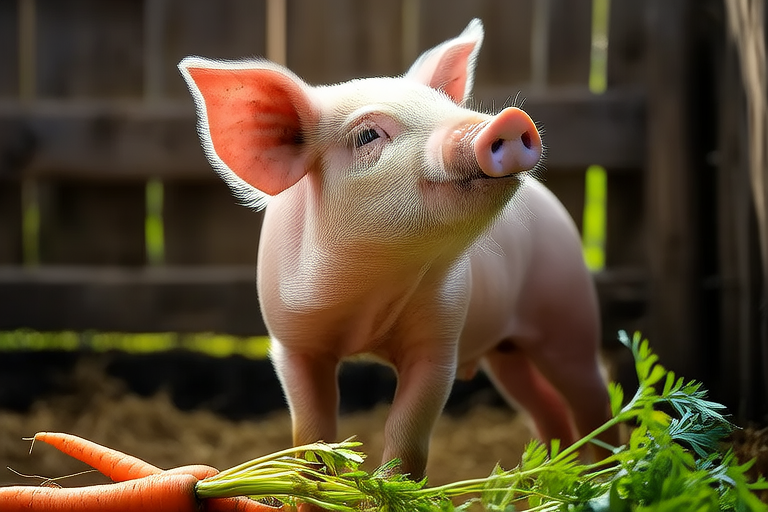Mini Pig Myths Busted: What Every Owner Should Know
Introduction
Mini pigs have become increasingly popular as pets over the past decade. Their intelligence, affectionate nature, and relatively small size make them appealing companions for many families. However, there are numerous misconceptions surrounding these animals that can lead to improper care and unrealistic expectations. This article aims to dispel some of the most common myths about mini pigs and provide valuable information for both prospective and current owners.
Myth 1: Mini Pigs Grow to Be as Big as Full-Sized Pigs
One of the most prevalent misconceptions about mini pigs is that they grow to be as large as full-sized pigs. In reality, mini pigs, also known as teacup or micro pigs, typically weigh between 50 to 70 pounds when fully grown. While there is variability among breeds and individual genetics, it’s important to research the specific breed you’re interested in to understand its expected adult size. For instance, breeds like the Juliana pig usually reach weights of around 40-60 pounds, whereas KuneKunes may grow slightly larger but still remain well under 100 pounds.
Myth 2: All Pigs Require Large Outdoor Spaces
Another misconception is that mini pigs need vast areas to roam freely. While providing outdoor access is beneficial for their physical and mental health, mini pigs can thrive in smaller environments if given appropriate enrichment. Dr. Sarah Thompson, a veterinarian specializing in exotic animals, explains, “Mini pigs are highly adaptable creatures. They enjoy exploring new spaces but don’t necessarily require acres of land.” Ensuring your mini pig has access to a secure, fenced area where they can dig, root, and play will suffice.
Myth 3: Pigs Eat Everything Including Trash
The idea that pigs will consume anything, including non-food items, is another common myth. Mini pigs are omnivores with a preference for plant-based foods. A balanced diet consisting of high-quality commercial pig feed, fresh vegetables, fruits, and occasional treats like cooked sweet potatoes or bananas is ideal. Avoid feeding them processed human food, sugary snacks, or any products containing artificial preservatives. Dr. Thompson advises, “Aim for a varied diet rich in nutrients while avoiding excessive carbohydrates which can lead to obesity.”
Myth 4: Mini Pigs Are Dirty Animals
Contrary to popular belief, mini pigs are clean animals that spend considerable time grooming themselves. Like cats, they use their tongues to lick their fur, keeping themselves tidy. Providing regular opportunities for bathing, especially during warmer months, helps maintain their hygiene. Grooming sessions also offer bonding time between owner and pet. Additionally, ensuring your mini pig has access to clean bedding and water encourages good hygiene practices.
Proper Feeding and Exercise Needs
Feeding Tips: Mini pigs require a diet tailored to meet their nutritional needs. Consult with a veterinarian familiar with pig care to determine the appropriate amount and type of food based on age, weight, and activity level. Overfeeding can lead to obesity, joint problems, and other health issues.
Exercise Needs: Regular exercise is crucial for maintaining a healthy weight and preventing behavioral issues such as boredom-induced destructive behaviors. Interactive toys, puzzle feeders, and supervised outdoor playtime promote physical activity and mental stimulation.
Grooming and Training Techniques
Grooming: Regular brushing helps remove loose hair and prevents matting. Use a soft-bristled brush designed for small animals. Pay special attention to areas prone to tangles, such as behind the ears and around the tail. Trim nails every few weeks if necessary.
Training Techniques: Positive reinforcement methods work best when training mini pigs. Reward desired behaviors with treats, praise, or gentle petting. Consistency is key; ensure all family members use the same commands and rewards system. Basic commands like ‘sit,’ ‘stay,’ and ‘come’ can enhance communication and safety.
Adopting From Reputable Sources
When considering adopting a mini pig, choose a reputable breeder or rescue organization. Research potential sources thoroughly to avoid supporting unethical practices. Look for breeders who prioritize the health and welfare of their animals, offering health guarantees and documentation regarding vaccinations and deworming schedules.
Integrating Into Family Life
Introducing a mini pig into your home requires careful planning to ensure a smooth transition. Create a designated space within the house where your pig feels safe and comfortable. Gradually introduce family members, allowing ample time for bonding and establishing trust. Consider enrolling in obedience classes specifically designed for pigs to strengthen the bond and teach essential commands.
Conclusion
Understanding the true nature of mini pigs allows us to provide them with the loving homes they deserve. By addressing common misconceptions and focusing on proper care, we can help these intelligent, affectionate animals thrive in domestic settings. Remember, responsible ownership involves ongoing education and commitment to meeting the unique needs of your mini pig companion.
